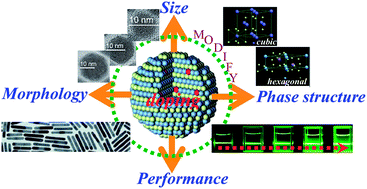Many technological nanomaterials are intentionally ‘doped’ by introducing appropriate amounts of foreign elements into hosts to impart electronic, magnetic and optical properties. In fact, impurity doping was recently found to have significant influence on nucleation and growth of many functional nanocrystals (NCs), and provide a fundamental approach to modify the crystallographic phase, size, morphology, and electronic configuration of nanomaterials. In this feature article, we provide an overview of the most recent progresses in doping-induced control of phase structures, sizes, shapes, as well as performances of functional nanomaterials for the first time. Two kinds of impurity doping strategies, including the homo-valence ion doping and hetero-valence ion doping, are discussed in detail. We lay emphases on impurity doping induced modifications of microstructures and optical properties of upconversion (UC) lanthanide (Ln3+) NCs, but do not limit to them. In addition, we also illustrate the control of Ln3+ activator distribution in the core@shell architecture, which has recently provided scientists with new opportunities for designing and tuning the multi-color emissions of Ln3+-doped UC NCs. Finally, the challenges and future perspectives of this novel impurity doping strategy are pointed out.


 Please wait while we load your content...
Please wait while we load your content...